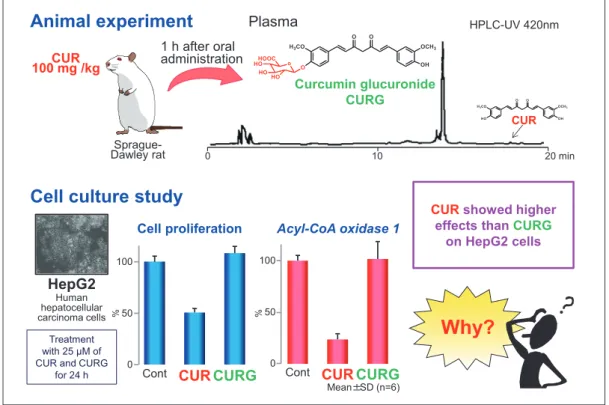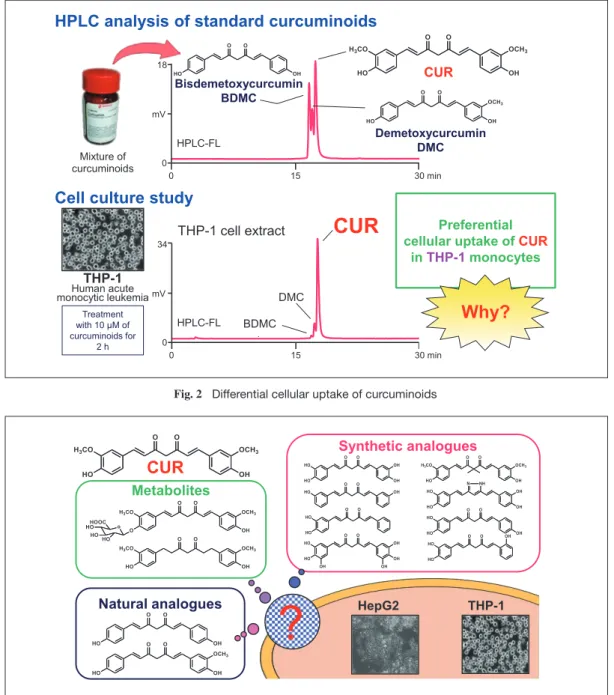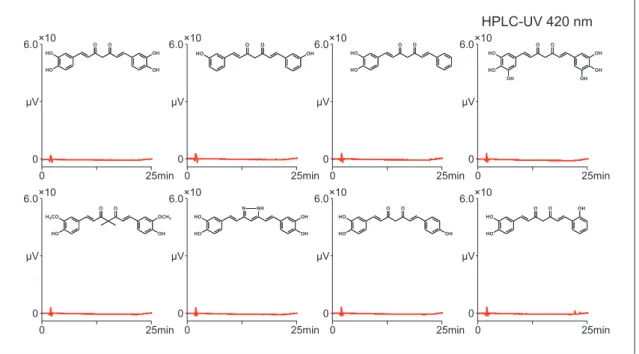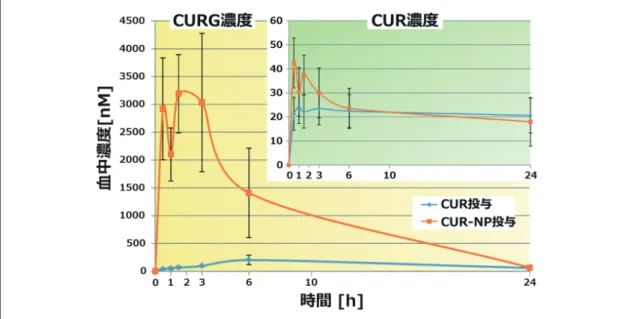<平成26年度助成>
クルクミンおよび類縁体の培養細胞への取り込み量の評価:
細胞内移行と生理作用発現機構の関係解明に向けて
仲 川 清 隆
(東北大学大学院農学研究科)1. クルミンおよび類縁体の培養細胞への
取り込み量の評価
ウコンに含まれるクルクミン(CUR)は、脂質低
下などの生理作用が知られる
1 - 8 )。ヒトや動物が
CURを摂取すると、体内で代謝され、クルクミン
グルクロン酸抱合体(CURG)が主要代謝物として
血中に認められる(Fig. 1)
9 - 11 )。しかし、CURGが
生理作用の主体かは不明な点が多い。先に我々は、
CURとCURGの生理作用を培養細胞試験で調べ、
CURGは CURに比べてヒト肝ガン細胞HepG2に
あまり影響しないことを報告した(Fig. 1)
12 )。ま
た、我々の別の実験では、CURとともに類縁体
デメトキシクルクミン(DMC)、ビスデメトキシク
ルクミン(BDMC)をヒト白血球単球細胞THP-1
に加えると、細胞から専らCURが検出された
(Fig. 2)
13 )。これらのことから、CURは何らかの
機構で積極的に細胞内に取り込まれ、生理機能を
示すと予想された。
この証明に向けて、はじめに本研究では、CUR
や CURG、還元代謝物(テトラヒドロクルクミン
(THC))、類縁体(DMC や BDMC、合成類縁体)
をHepG2 および THP-1 に加え、取り込み量や代
謝を比較し、CURの選択的な取り込みの有無を
明らかにしようとした(Fig. 3)。CUR や CURG、
THCを細胞に処理し、細胞抽出物をHPLC分析
すると、HepG2 や THP-1からはCURが多く検出
され、CURGは検出限界以下で、THCもほとん
ど認められなかった(Fig. 4; HepG2の解析例)。
続いて、CURとさらに構造の類似した化合物
(DMC や BDMC、および合成類縁体)の取り込み
Fig. 1 Comparison of effects of CUR and metabolites
Animal experiment
Mean±SD (n=6) 0 50 100 Cont Cell proliferationCURshowed higher effects than CURG
on HepG2 cells
Sprague-Dawley rat 0 10 20 min
Curcumin glucuronide CURG HPLC-UV 420nm Human hepatocellular carcinoma cells
Cell culture study
CUR 100 mg /kgWhy?
CUR CURCURG HepG2 0 50 100Cont CURCURG
Acyl-CoA oxidase 1 % Plasma % 1 h after oral administration Treatment with 25 µM of CUR and CURG
for 24 h
Bisdemetoxycurcumin BDMC THP-1 Human acute monocytic leukemia CUR
CUR
DMC BDMC Preferential cellular uptake of CURin THP-1monocytes
HPLC analysis of standard curcuminoids
Cell culture study
18 0 0 30 min mV 15 HPLC-FL 34 HPLC-FL 0 0 30 min mV 15 THP-1 cell extract
Why?
Demetoxycurcumin DMC Mixture of curcuminoids Treatment with 10 µM of curcuminoids for 2 hFig. 2 Differential cellular uptake of curcuminoidsFig. 2 Differential cellular uptake of curcuminoids
CUR
Metabolites Natural analogues Synthetic analogues THP-1?
HepG2Fig. 3 Comparison of cellular uptake of CUR and other related molecules in order to gain insight on mechanism of CUR activities
Fig. 4 Differential cellular uptake of CUR, CURG, and THC
HPLC-FL Ex 429 nm, Em 539 nm HPLC-FL Ex 429 nm, Em 539 nm HPLC-UV Absorbance at 280 nm CURG CUR THC 6.0 0 µV 0 10 20 ×10
CUR standard 100 pmol
min 3.0 0 µV 0 10 20 ×10 CURG standard 200 pmol min µV 6.0×10³ 0 0 10 20 THC standard 100 pmol min µV 6.0×10³ 0 0 10 20min HepG2 extract 10 µM 1 h THC, N.D. HepG2 extract 10 µM 1 h 6.0 0 µV 0 10 20 ×10 min 90 pmol/1× 10 cells HepG2 extract 10 µM 1 h 3.0 µV 0 10 20 ×10 min CURG, N.D. 0
Fig. 3 Comparison of cellular uptake of CUR and other related molecules in order to gain insight on mechanism of CUR activities
を調べたが、いずれも細胞からきわめて微量しか
検出されない、あるいは検出限界以下であった
(Figs. 5, 6 ; いずれもHepG2の解析例)。以上よ
り、CURは代謝物および類縁体と区別されて積
極的に細胞に取り込まれている可能性が新たに示
唆された。
2. クルミンの細胞内移行機構の解明:生理作用
発現機構との関係性
上述の知見から、CURを特異的に認識できる
タンパク質(CURレセプター)の存在を想定して、
種々の阻害剤を用いた実験を現在進めている。
具体的には、ある種のポリフェノールや脂溶性
ビタミンの細胞内移行に関わるとされるトラン
スポーター(カチオントランスポーター、アニオ
ントランスポーター)の 阻 害 剤(glibenclamide、
probenecid、等)を細胞に処理し、その後にCUR
を細胞に加え、阻害剤の影響を調べている。これ
らの実験において、ある阻害剤の有用性を認めつ
つあり、重点的に解析を進めている。
ちなみに、CURのレセプターを示唆する論文は
Fig. 5 Differential cellular uptake of CUR, DMC, and BDMC
BDMC
CUR
DMC 0 6.0 µV 0 10 20 ×10 HPLC-UV 420 nm 100 pmol standard 0 6.0 µV 0 10 20 ×10 HPLC-UV 420 nm 100 pmol standardHepG2 extract HepG2 extract HepG2 extract 6.0 0 µV 0 10 20 ×10 min Cell extract 10 uM 1 h 6.0 0 µV 0 10 20 ×10 min 6.0 0 µV 0 10 20 ×10 min 0 6.0 µV 0 10 20 ×10 HPLC-UV 420 nm 100 pmol standard
min min min
Fig. 6 Differential cellular uptake of synthetic CUR analogues
6.0 0 0 25min µV ×10 HPLC-UV 420 nm 6.0 0 0 25min µV ×10 6.0 0 0 25min µV ×10 6.0 0 0 25min µV ×10 6.0 0 0 25min µV ×10 6.0 0 0 25min µV ×10 6.0 0 0 25min µV ×10 6.0 0 0 25min µV ×10
Fig. 5 Differential cellular uptake of CUR, DMC, and BDMC
過去にひとつあるが、この論文は取り下げられて
いる。したがって、CURレセプターの存在は未
だ明らかにされていない。今後も本研究を推進し
てCURレセプターの存在を証明し、CURレセプ
ターの発現を増強できれば、CUR作用のより効
果的な享受法の構築へと展開でき、CURの健康
機能に関する新しい方法論の提供が可能になると
期待される。例えば、
“レセプターの発現増強を介
した CUR作用を受け取りやすい食事の提案”、あ
るいは“レセプターの発現機構の違いによる CUR
作用の個人差とその解決策の構築”、等々、従来に
無い着想と方法論を世界に提案できると考えて
いる。
3. クルクミン封入ナノ粒子の吸収代謝の評価:
生理作用発現機構との関係性
昨今、CURの生物学的利用能の改善に向けて
CURをナノ粒子に封入する試みが行われてい
る
14 - 21)。そこで、本研究を進める過程で、ナノ粒
子作製に広く用いられる生分解性ポリマー(ポリ
乳酸・グリコール酸共重合体:PLGA)を用いて
Fig. 7 Comparison of in vivo plasma concentration vs. time profiles
Fig. 8 Comparison of CUR concentration in micelles
Fig. 7 Comparison of in vivo plasma concentration vs. time profiles
CUR 封入ナノ粒子(CUR-NP)を調製し、その細
胞への取り込み試験も行ったところ、確かに、細
胞への取り込みが見られた。現状で、CUR-NP
の体内への取り込み量やCUR代謝におよぼす影
響は未だ不明な点が多いことから、本研究におい
て
in vivo
および
in vitro
試験を行い、CUR-NPの
吸収代謝を明らかにしようとした。
その結果、CUR-NPを投与したラット血漿か
らは多量にCURGが検出されたものの、CURは
微量であることがわかった。他方、CURを与えた
ラット血漿のCURG濃度は低く、CURはほとんど
存在しなかった(Fig. 7)。したがって、CUR-NPは
CURの吸収性を高めるが、ほとんど CURG に代謝
されると考えられた。
In vitro
試験では、CURを
用いて調製したミセルよりも、CUR-NPを用いた
ミセルの方がCUR溶解量が多く(Fig. 8)、このこ
とからラットにおけるCUR-NPとCUR の吸収性の
違いは、両者の胆汁酸ミセルへの取り込まれ易さ
の違いと予想された。これらのことから、CURの
吸収性を高めるには、CURをナノ粒子に封入する
ことは有効であるが、ナノ粒子化による生理作用
向上に関しては更なる研究が必要と考えられた。
4. お わ り に
CUR をはじめとする多くのポリフェノール等
の食品成分は、吸収代謝と生理作用発現機構の関
係について、十分な解明がなされているとは言え
ない面がある。こうした中で、本研究の成果は、
CUR の吸収・代謝的特性を明確にし、食品の新
しい機能発見に繋がり、疾病予防に役立つので、
社会的意義が大きいと思われる。
謝 辞
本研究の実施に当たり、研究助成を頂きました
(公財)浦上食品・食文化振興財団に心より御礼申
し上げます。今後も、引き続き本研究を進めてい
く所存です。
文 献1) Asai, A & Miyazawa, T (2001) Dietary curcuminoids prevent high-fat diet-induced lipid accumulation in rat liver and epididymal adipose tissue. J Nutr 131, 2932-2935 2) Sharma, RA, Gescher, AJ & Steward, WP (2005) Curcumin:
the story so far. Eur J Cancer 41, 1955-1968.
3) Ejaz, A, Wu, D, Kwan, P & Meydani, M (2009) Curcumin inhibits adipogenesis in 3T3-L1 adipocytes and angiogenesis and obesity in C57/BL mice. J Nutr 139, 919-925.
4) Zingg, JM, Hasan, ST & Meydani, M (2013) Molecular mechanisms of hypolipidemic effects of curcumin. Biofactors39, 101-121.
5) Zingg, JM, Hasan, ST, Cowan, D, Ricciarelli, R, Azzi, A & Meydani M (2012) Regulatory effects of curcumin on lipid accumulation in monocytes/macrophages. J Cell Biochem 113, 833-840.
6) Sawada, H, Saito, Y & Noguchi, N (2012) Enhanced CD36 expression changes the role of Nrf2 activation from anti-atherogenic to pro-anti-atherogenic in apoE-deficient mice. Atherosclerosis225, 83 - 90.
7) Kou, MC, Chiou, SY, Weng, CY, Wang, L, Ho, CT & Wu MJ (2013) Curcuminoids distinctly exhibit antioxidant activities and regulate expression of scavenger receptors and heme oxygenase-1. Mol Nutr Food Res 57, 1598-1610. 8) Gupta, SC, Sung, B, Kim, JH, Prasad, S, Li, S & Aggarwal,
BB (2013) Multitargeting by turmeric, the golden spice: from kitchen to clinic. Mol Nutr Food Res 57, 1510-1528. 9) Pan, MH, Huang, TM & Lin, JK (1999) Biotransformation
of curcumin through reduction and glucuronidation in mice. Drug Metab Dispos27, 486-494
10) Asai, A & Miyazawa, T (2000) Occurrence of orally administered curcuminoid as glucuronide and glucuronide/ sulfate conjugates in rat plasma. Life Sci 67, 2785-2793. 11) Anand, P, Kunnumakkara, AB, Newman, RA & Aggarwal
BB (2007) Bioavailability of curcumin: problems and promises. Mol Pharm 4, 807-818.
12) Shoji, M, Nakagawa, K, Watanabe, A, Tsuduki, T, Yamada, T, Kuwahara, S, Kimura, F & Miyazawa, T (2014) Comparison of the effects of curcumin and curcumin glucuronide in human hepatocellular carcinoma HepG2 cells. Food Chem 151, 126-132.
13) Nakagawa, K, Zingg, JM, Kim, SH, Thomas, MJ, Dolnikowski, GG, Azzi, A, Miyazawa, T & Meydani, M (2014) Differential cellular uptake and metabolism of curcuminoids in monocytes/macrophages: regulatory effects on lipid accumulation. Br J Nutr 112, 8-14.
14) Sun, M, Su, X, Ding, B, He, X, Liu, X, Yu, A, Lou, H & Zhai, G (2012) Advances in nanotechnology-based delivery systems for curcumin. Nanomedicine (Lond) 7, 1085-1100. 15) Maradana, MR, Thomas, R & O’Sullivan, BJ (2013)
Targeted delivery of curcumin for treating type 2 diabetes. Mol Nutr Food Res57, 1550-1556
16) Ghalandarlaki, N, Alizadeh, AM & Ashkani-Esfahani, S (2014) Nanotechnology-applied curcumin for different diseases therapy. Biomed Res Int. 2014, 394264.
17) Ahmad, MZ, Akhter, S, Mohsin, N, Abdel-Wahab, BA, Ahmad, J, Warsi, MH, Rahman, M, Mallick, N & Ahmad, FJ (2014) Transformation of curcumin from food additive to multifunctional medicine: nanotechnology bridging the gap. Curr Drug Discov Technol11, 197-213.
18) Lee, WH, Loo, CY, Young, PM, Traini, D, Mason, RS & Rohanizadeh, R (2014) Recent advances in curcumin nanoformulation for cancer therapy. Expert Opin Drug Deliv 11, 1183-1201.
19) Hu, L, Pang, S, Hu, Q, Gu, D, Kong, D, Xiong, X & Su, J (2015) Enhanced antitumor efficacy of folate targeted nanoparticles co-loaded with docetaxel and curcumin. Biomed Pharmacother75, 26-32.
20) Leung, MH, Harada, T, Dai, S & Kee, TW (2015) Nanoprecipitation and spectroscopic characterization of curcumin-encapsulated polyester nanoparticles. Langmuir 31, 11419-11427.
21) Yallapu, MM, Nagesh, PK, Jaggi, M & Chauhan, SC (2015) Therapeutic applications of curcumin nanoformulations. AAPS J17, 1341-1356.



